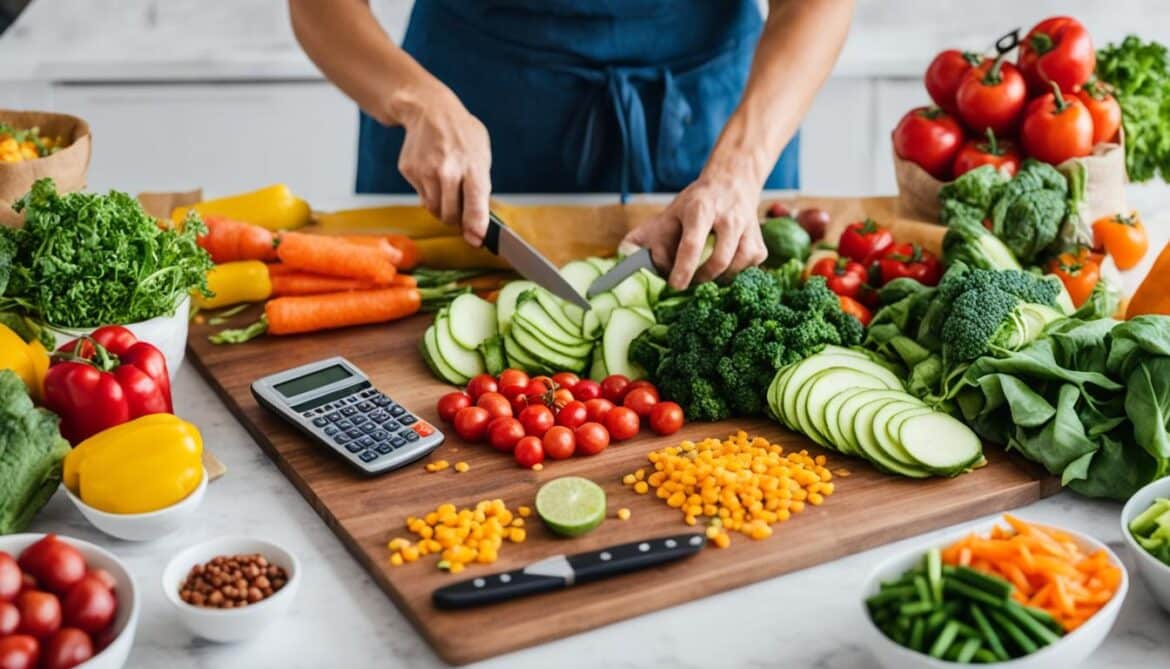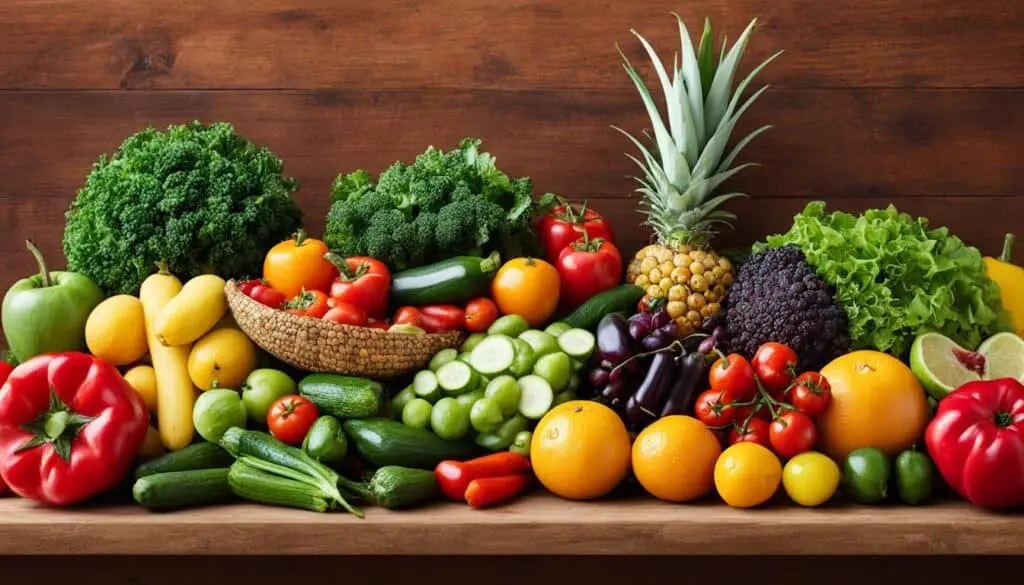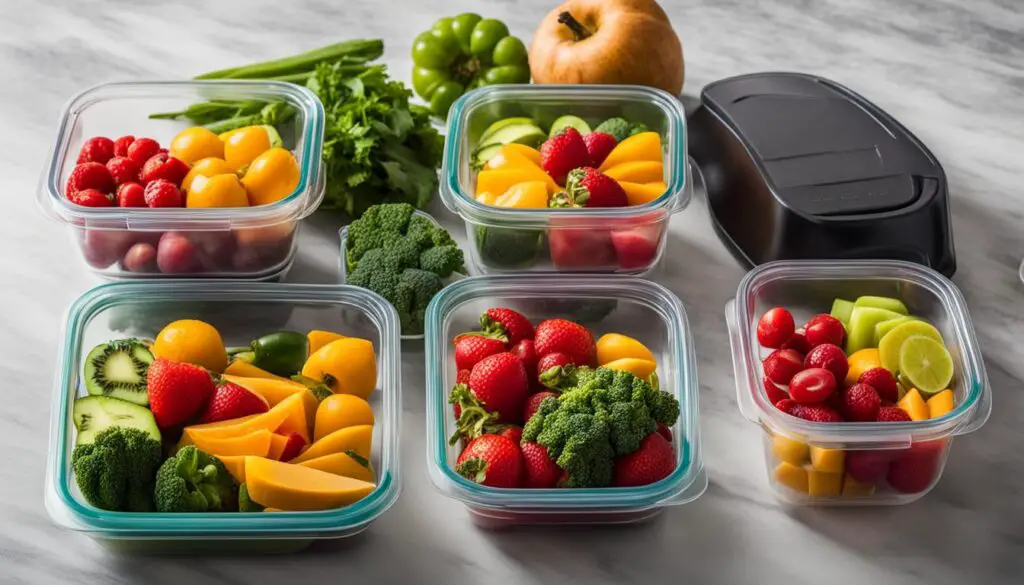According to the National Center for Health Statistics, nearly half of American adults are attempting to lose weight. As someone who has struggled with weight loss myself, I understand the challenges of finding a sustainable and affordable way to shed those extra pounds. That’s why I want to share with you my top tips for budget-friendly meal planning that can help you achieve your weight loss goals without breaking the bank.
Meal planning is an effective strategy for weight loss as it allows you to optimize your diet while staying within a budget. By planning your meals in advance, you can ensure that you have nutritious options on hand and avoid relying on expensive takeout or convenience foods. With the right planning and creativity, you can make every dollar count towards your weight loss journey.
Key Takeaways
- Budget-friendly meal planning can help you achieve your weight loss goals without straining your wallet.
- By planning your meals in advance, you can make healthier choices and avoid costly takeout or convenience foods.
- Focusing on affordable staple foods like fruits, vegetables, whole grains, and lean proteins can help you stay on budget while getting the nutrients you need.
- Investing in meal prep containers and batch cooking can save you time and money throughout the week.
- Eating healthy on a budget is possible by prioritizing whole foods, buying seasonal produce, and exploring plant-based protein sources.
The Benefits of Meal Planning for Weight Loss
Meal planning offers several benefits for weight loss. It helps you stay organized and avoid impulsive, unhealthy food choices. By planning your meals in advance, you can ensure that you have nutritious options on hand and avoid relying on expensive takeout or convenience foods. Additionally, meal planning can help you control portion sizes and ensure that you are consuming the right balance of nutrients for weight loss.
When you invest time in creating a meal plan, you are taking control of your eating habits and setting yourself up for success. Instead of making last-minute decisions based on cravings or convenience, you are making intentional choices that support your weight loss goals. By having a clear plan, you reduce the likelihood of resorting to unhealthy options that may derail your progress.
Meal planning also allows you to incorporate a variety of nutrient-dense foods into your diet. When you plan your meals in advance, you can ensure that each meal includes a balance of lean proteins, healthy fats, and complex carbohydrates. This balanced approach helps keep you satisfied and prevents excessive hunger that can lead to overeating or reaching for unhealthy snacks.
Another advantage of meal planning for weight loss is portion control. When you plan your meals, you can accurately portion out your food, ensuring that you are not consuming more calories than you need. This can be especially helpful if you tend to overeat or have difficulty judging portion sizes. By controlling the quantity of food you eat, you can create a calorie deficit necessary for weight loss without feeling deprived or hungry.
Moreover, meal planning can also help you save money. When you plan your meals in advance, you can create a grocery list with only the ingredients you need, reducing food waste. By avoiding spontaneous trips to the grocery store or ordering takeout, you can stick to your budget and save money in the long run.
Overall, meal planning is a valuable tool for weight loss. It allows you to stay organized, make healthier food choices, control portion sizes, and save money. By incorporating meal planning into your weight loss journey, you set yourself up for success and create sustainable habits that support long-term healthy eating.
Tips for Budget-Friendly Meal Planning
When it comes to budget-friendly meal planning for weight loss, there are several strategies you can implement. First, focus on affordable staple foods such as fruits, vegetables, whole grains, and lean proteins. These foods are not only nutritious but also cost-effective. Consider buying in bulk, using frozen or canned fruits and vegetables, and opting for cheaper cuts of meat or plant-based protein sources. Plan your meals around sales and discounts, and make use of leftovers to reduce food waste.
1. Prioritize Affordable and Nutritious Foods
When budgeting for your meals, prioritize affordable yet nutritious ingredients. Incorporate a variety of fruits, vegetables, whole grains, and lean proteins into your meal plans. These food groups not only provide essential nutrients but also tend to be more affordable compared to processed and packaged foods.
2. Buy in Bulk and Utilize Frozen and Canned Options
Buying in bulk is a great way to save money on staple ingredients. Look for deals at your local grocery store or consider joining a wholesale store like Costco or Sam’s Club. Additionally, utilizing frozen or canned fruits and vegetables can be a budget-friendly alternative, as they often have a longer shelf life and can be more cost-effective.
3. Opt for Affordable Protein Sources
Protein is an essential nutrient for weight loss, but it can sometimes be costly. To stay within your budget, consider opting for cheaper cuts of meat or exploring plant-based protein sources such as beans, lentils, tofu, or tempeh. These options provide ample protein at a more affordable price point.
4. Plan Meals Around Sales and Discounts
Keep an eye out for sales and discounts at your local grocery store or supermarket. Meal planning around these promotions allows you to take advantage of lower prices on various ingredients. Additionally, consider signing up for loyalty programs or subscribing to newsletters from your favorite stores to stay updated on special deals.
5. Make Use of Leftovers
Reducing food waste is not only budget-friendly but also environmentally conscious. Incorporate leftover ingredients and meals into your meal plans. Get creative by transforming yesterday’s dinner into a delicious lunch or repurposing unused vegetables into a stir-fry or soup. Making use of leftovers helps you save money while minimizing food waste.
Meal planning on a budget doesn’t mean compromising on taste or nutrition. With some smart strategies and a little creativity, you can enjoy delicious and affordable meals while working towards your weight loss goals. Remember to plan ahead, prioritize affordable ingredients, and make the most of discounts and leftovers.
Now that you have some practical tips for budget-friendly meal planning, it’s time to put them into action. By incorporating these strategies into your routine, you can save money while enjoying nutritious and satisfying meals.
| Benefits of Budget-Friendly Meal Planning |
|---|
| 1. Helps save money by prioritizing affordable ingredients |
| 2. Reduces food waste through strategic use of leftovers |
| 3. Provides a structured approach to meal preparation and portion control |
| 4. Promotes healthier eating habits by emphasizing nutritious foods |
| 5. Supports weight loss goals by planning well-balanced meals |
Healthy and Affordable Recipe Ideas
Incorporating healthy and affordable recipes into your meal planning can help you stay on track with your weight loss goals. Below are some budget-friendly recipe ideas that are delicious and packed with nutrition.
1. Vegetable Stir-Fries
Vegetable stir-fries are a great way to incorporate a variety of colorful veggies into your meals. They are quick, easy to prepare, and budget-friendly. Sautee your favorite vegetables like bell peppers, broccoli, carrots, and mushrooms in a small amount of oil. Add some lean protein like chicken breast or tofu, and season with soy sauce, garlic, and ginger for a burst of flavor. Serve over brown rice or quinoa for a complete meal.
2. Quinoa Salads
Quinoa is a nutritious, protein-rich grain that is affordable and versatile. Make a quinoa salad by cooking quinoa according to package instructions, then combining it with a variety of chopped vegetables, such as cucumbers, tomatoes, and red onions. Add some cooked beans or chickpeas for an extra protein boost. Dress the salad with a simple vinaigrette made with olive oil, vinegar, and herbs. This refreshing salad can be enjoyed as a main dish or a side.
3. Lentil Soups
Lentils are an affordable source of plant-based protein and are packed with fiber. Whip up a hearty lentil soup by simmering lentils with vegetables like carrots, celery, and onions in a vegetable or chicken broth. Season with herbs and spices like cumin, paprika, and thyme for added flavor. This nourishing soup is filling, delicious, and perfect for weight loss.
4. Homemade Granola Bars
Store-bought granola bars can be expensive and filled with added sugars. Make your own healthy and budget-friendly granola bars at home. Mix together oats, nuts, seeds, dried fruits, and a small amount of honey or maple syrup. Press the mixture into a baking dish and bake until golden brown. Cut into bars and enjoy as a convenient and nutritious snack.
5. Berry Smoothies
Smoothies are a great way to incorporate fruits into your diet and can be customized to suit your taste preferences. Blend together a mixture of frozen berries (such as strawberries, blueberries, and raspberries), a banana, spinach, Greek yogurt, and a liquid of your choice (such as almond milk or coconut water). This refreshing and filling smoothie makes for a satisfying and budget-friendly meal or snack.
These recipe ideas provide a balance of protein, carbohydrates, and healthy fats and can be easily included in your meal planning for effective weight loss without breaking the bank.
| Recipe | Ingredients | Preparation |
|---|---|---|
| Vegetable Stir-Fries | A variety of colorful vegetables, lean protein (chicken breast or tofu), soy sauce, garlic, ginger, oil | Sautee vegetables and protein in oil. Season with soy sauce, garlic, and ginger. Serve over rice or quinoa. |
| Quinoa Salads | Quinoa, vegetables (cucumbers, tomatoes, red onions), beans or chickpeas, olive oil, vinegar, herbs | Cook quinoa. Combine with vegetables and beans or chickpeas. Dress with olive oil, vinegar, and herbs. |
| Lentil Soups | Lentils, vegetables (carrots, celery, onions), vegetable or chicken broth, herbs, spices | Simmer lentils and vegetables in broth. Season with herbs and spices. Serve hot. |
| Homemade Granola Bars | Oats, nuts, seeds, dried fruits, honey or maple syrup | Mix ingredients together. Press into a baking dish. Bake until golden brown. Cut into bars. |
| Berry Smoothies | Frozen berries, banana, spinach, Greek yogurt, liquid (almond milk, coconut water) | Blend all ingredients together until smooth. Enjoy immediately. |
Meal Prep Tips for Weight Loss
Meal prep is an essential component of successful weight loss and budget-friendly meal planning. By setting aside a specific day or time each week to plan and prepare your meals, you can save time and ensure that you always have healthy options available. Here are some meal prep tips to help you on your weight loss journey:
- Invest in Meal Prep Containers: Portioning out your meals in advance using meal prep containers makes it easy to grab and go. These containers are designed to keep your food fresh and can be placed in the refrigerator or freezer for later use.
- Batch Cook Ingredients: To save even more time, consider batch cooking ingredients that can be used in multiple recipes throughout the week. For example, roasting a large batch of vegetables or grilling chicken breasts can provide the foundation for different meals, such as salads, stir-fries, or grain bowls.
- Plan Your Meals: Take the time to plan your meals for the week ahead. This not only helps you stay organized but also ensures that you have a balanced and nutritious diet. Consider including a variety of vegetables, lean proteins, whole grains, and healthy fats in your meal plan.
- Prep Ingredients in Advance: Prepping ingredients in advance can save you valuable time during the week. Chop vegetables, cook grains, and marinate proteins ahead of time, so they’re ready to be used in your recipes.
Remember, successful meal prep requires consistency and dedication. It may take some trial and error to find a routine that works best for you, but the benefits are worth it.
Example Meal Prep Schedule:
| Day | Task |
|---|---|
| Sunday | Grocery shopping |
| Monday | Prep and portion vegetables |
| Tuesday | Cook proteins and grains |
| Wednesday | Assemble and portion meals |
| Thursday | Prep snacks and smoothies |
| Friday | Enjoy your prepped meals! |
Following a meal prep schedule like the one above can help you stay on track and simplify your weekly meal planning process.
Strategies for Eating Healthy on a Budget
Eating healthy on a budget is possible with a few strategies that I’ve learned along the way. By following these tips, you can nourish your body without breaking the bank. Here are some budget-friendly ways to eat healthy:
1. Plan your meals around sales and discounts
One of the best ways to eat healthy on a budget is to shop smart. Keep an eye out for sales and discounts at your local grocery store. Plan your meals based on the items that are on sale, which can help you save money while still enjoying nutritious meals.
2. Buy seasonal produce
Seasonal produce tends to be fresher, tastier, and more affordable. Incorporate fruits and vegetables that are in season into your meals. Not only will you save money, but you’ll also enjoy the flavors that nature has to offer.
3. Join a community-supported agriculture program
Consider joining a community-supported agriculture (CSA) program or shopping at farmer’s markets. These options allow you to support local farmers while getting affordable fruits and vegetables. It’s a win-win situation for both your budget and the community.
4. Limit processed and packaged foods
Processed and packaged foods often come with a higher price tag and are less nutritious than whole foods. Instead, focus on whole foods like fruits, vegetables, whole grains, and lean proteins. These options are not only healthier but also more budget-friendly.
5. Be creative with plant-based protein sources
Plant-based protein sources, such as beans, lentils, and tofu, are typically more affordable than animal protein. Incorporate these options into your meals to save money without compromising on nutrition. Experiment with different recipes and flavors to keep things interesting.
By implementing these strategies, you can prioritize your health and well-being without breaking the bank. Remember, eating healthy on a budget is all about making smart choices and being resourceful.
Conclusion
Budget-friendly meal planning is a crucial component of achieving your weight loss goals. By implementing the tips and strategies provided in this article, you can optimize your diet without straining your finances. Prioritizing nutrient-dense foods, planning your meals in advance, and incorporating affordable ingredients are key factors in successfully losing weight on a budget.
When it comes to budget-friendly meal planning, remember to focus on affordable staple foods such as fruits, vegetables, whole grains, and lean proteins. Taking advantage of bulk purchases, frozen or canned produce, and less expensive cuts of meat or plant-based protein sources can help you save money without sacrificing nutrition.
Incorporating healthy and affordable recipes into your meal planning is a great way to stay on track with your weight loss journey. Look for recipes that utilize inexpensive ingredients and provide a balanced mix of protein, carbohydrates, and healthy fats. Additionally, investing in meal prep containers and batch cooking can save you time and ensure that you always have satisfying, nutritious meals readily available.
In conclusion, budget-friendly meal planning is not only achievable but also highly effective for weight loss. By being proactive and creative with your ingredients, you can successfully lose weight while staying within your budget. Start implementing these strategies today and embrace a healthier lifestyle without breaking the bank.
FAQ
How can meal planning help with weight loss?
Meal planning helps with weight loss by allowing you to stay organized and avoid unhealthy food choices. It also helps control portion sizes and ensures a balanced nutrient intake for weight loss.
What are some budget-friendly meal planning tips?
Some budget-friendly meal planning tips include focusing on affordable staple foods, buying in bulk, using frozen or canned fruits and vegetables, planning meals around sales and discounts, and making use of leftovers.
What are some healthy and affordable recipe ideas for weight loss?
Some healthy and affordable recipe ideas for weight loss include vegetable stir-fries, quinoa salads, lentil soups, and homemade granola bars. Look for recipes that use inexpensive ingredients and offer a good balance of nutrients.
How can meal prep help with weight loss?
Meal prep is essential for weight loss as it allows you to plan and prepare your meals in advance. It saves time, ensures you have healthy options available, and helps with portion control.
What are some strategies for eating healthy on a budget?
Some strategies for eating healthy on a budget include planning meals around sales and discounts, buying seasonal produce, joining a community-supported agriculture program or shopping at farmers’ markets, limiting processed and packaged foods, and exploring plant-based protein sources.
Source Links
- https://www.eatingwell.com/what-is-the-80-20-diet-is-it-healthy-8417695
- https://www.skinnytaste.com/free-7-day-healthy-meal-plan-jan-8-14/
- https://www.forbes.com/health/supplements/nicotinamide-mononucleotide/



